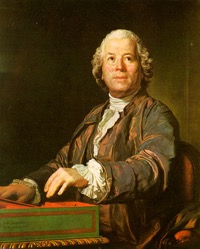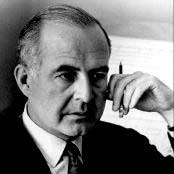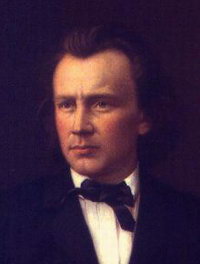| Three Centuries of Romanticism | ||||||||||
Overture to Iphigénie en Aulide Reorchestrated by Richard Wagner Gluck is one of the few composers of note who seems to have been completely self-taught. Raised by his father, a forester who tried to discourage his son’s musical bent, Gluck left home as a teenager to follow a musical career. His fame gradually spread during the course of holding several minor musical posts in central Europe. His first known composition was a full-fledged opera, Artaserse, set to a libretto by Pietro Metastasio. Metastasio had a kind of stranglehold on libretto writing in early and mid eighteenth century and his texts were repeatedly set to music by composers from all over Europe. For decades, the opera seria, as it was called, ruled the boards. It followed a standard and rather monotonous structure consisting of scene after scene of recitative followed by an aria in ABA form. The subject matter was generally about an historical event – often considerably fictionalized – in the lives of some ancient king or queen, or a dramatization of a scene from an Italian Renaissance epic poem. Gluck’s early operas are in the opera seria genre, but in 1760 in Vienna, Gluck met the poet Raniero Calzabigi, who introduced him to the raging battle in Paris between adherents of the Italian opera seria and the indigenous French operatic tradition stemming from the court of Louis XIV Weary of the old opera seria, Gluck collaborated with Calzabigi to create a new operatic style more varied musically and directly expressive of the text, in accordance with neo-classical principles of simplicity and humanism espoused during the Enlightenment. Their first foray into new operatic territory was Orfeo ed Euridice, which premiered in Vienna in1762. The French version, an actual re-composition of the opera, premiered in Paris in 1774 and started another veritable war between the supporters of Gluck and Piccini, a composer of the standard opera seria. Gluck became the darling of Paris, where he moved in 1773. Iphigénie en Aulide, premiered in 1774, was the first opera he composed for Paris. It takes place during the Trojan War, and involves King Agamemnon’s emotional crisis on whether to sacrifice his daughter Iphigénie in order to sail for Troy or defy the goddess Diana [sic] and marry her off to Achilles. With the appearance by Clytemnestra, the audience is reminded of the adulterous and murderous unforeseen consequences of his decision – although Iphigénie is rescued by the goddess herself as a dea ex machina. While initially not a great success – its first run was cut short by the death of Louis XV – the opera became an annual event, raking up over 400 performances in Paris over the next 50 years. In 1847, Richard Wagner made a German version for the Dresden court, significantly altering the libretto and “modernizing” the orchestration. He even added some new music of his own. In 1854 he expanded the orchestration of the overture by adding winds and a 32 bar conclusion. The Overture too departs from the standard opera seria template. Gluck sets up the tragic no-win circumstances in a grim introduction.  But instead of a rousing allegro, he continues with a majestic theme, which is repeated like a rondo throughout the Overture. But instead of a rousing allegro, he continues with a majestic theme, which is repeated like a rondo throughout the Overture.  These two themes suggest Agamemnon’s dilemma of love over duty. These two themes suggest Agamemnon’s dilemma of love over duty. | ||||||||||
Concerto for Violin and Orchestra, Op. 14 The lyricism of Samuel Barber and other Neo-Romantics – including William Schuman, Howard Hanson and Leonard Bernstein – were sidelined after World War II by the academic dominance of atonality and serialism in American classical music. Although Barber and his “retro” colleagues eschewed the avant-garde in favor of old-fashioned tonality and lush melodic lines, they introduced into their music harmonies and intervals that would have shocked the audiences of the late nineteenth century. Barber showed early on a prodigious talent for composing – at ten he composed his first opera. He was encouraged, but not pushed, by his family, especially his aunt and uncle, contralto Louise Homer and composer Sidney Homer. The two served as his mentors for more than 25 years and profoundly influenced his aesthetic development. At age 14 he enrolled in the newly founded Curtis School of Music in Philadelphia, where he studied voice, piano and composition, graduating in 1934. Two of his early compositions, a Violin Sonata in 1928 and his first published large-scale work, The School for Scandal Overture (1931), won him prizes and, more importantly, public performances that brought him to the attention of the leading conductors of the day. During the height of the Depression in 1935, Barber won the prestigious American Prix de Rome, which gave him the opportunity of two years of study and work at the American Academy in Rome, where he rubbed shoulders with other young artists and an enlightened and progressive faculty. One of the first products of this sojourn was the Symphony No.1, completed in 1936. In early 1939, Samuel Fels, a wealthy Philadelphia soap manufacturer, commissioned Samuel Barber to write a violin concerto for his protégé, the young violinist Isaak (changed to Iso) Briselli. Barber’s commission was a hefty $1000 and he received half of it in advance. This was Barber’s first major commission, and he immediately set out to fulfill it. But commissions, while usually sought after by composers, clearly carry their own conditions and risks. Things did not go according to plan, and what actually happened became a Cause célèbre. Since all the protagonists have died, it remained for a paper trail to ascertain whose version was the true one. In the process, a lot of egos got nicked. According to Barber’s biographer Nathan Broder, by the end of the summer of 1939 the composer sent Briselli the first two movements, written in a conservative lyrical and romantic style. Briselli, however, considered them “too simple and not brilliant enough” and refused to accept them. Barber supposedly took his revenge by making the third movement fiendishly difficult. When he resubmitted it, Briselli declared it unplayable, and Fels wanted his advance commission back. At that point in the story, Barber summoned Herbert Baumel, a young violin student from the Curtis Institute of Music and an excellent sight-reader, and gave him the manuscript and two hours to prepare. Accompanied by a piano, the student supposedly demonstrated that the movement was indeed playable. The unanimous verdict was that Fels had to pay the rest of the commission. Barber, however, forfeited the second half and, in exchange, Briselli relinquished his right to the first public performance and never performed the concert in public. Briselli, some 40 years later, told a different story, and a paper trail collected by his friends and supporters has essentially corroborated his account. According to Briselli, he was enthusiastic about the first two movements but his violin coach, Albert Mieff, was not and even wanted to rewrite the violin part so that it would be more in keeping with the technical expectations for a concerto, citing Brahms collaboration with Joachim as a precedent. Moreover, Briselli found the third movement too lightweight – rather than too difficult – and suggested that Barber expand it. The composer refused and he and Briselli mutually decided to abandon the project with no hard feelings on either side. For a while there was even talk of Briselli suing Barber for defamation of character over the composer's version of the controversy. (A full account of Briselli's side can be found on his website www.Iso Briselli.com.) The Concerto was finally premiered by Albert Spalding and the Philadelphia Orchestra in 1941 and was a popular success from the start. The first movement, Allegro, opens with an expansive, lyrical theme on the violin.  The second theme functions also as a brief refrain throughout the movement. The second theme functions also as a brief refrain throughout the movement.  The whole ambiance of the movement suggests that of a quiet discussion, with only occasionally raised voices in the middle, and ending in a tranquil whisper after a short cadenza for the soloist. The whole ambiance of the movement suggests that of a quiet discussion, with only occasionally raised voices in the middle, and ending in a tranquil whisper after a short cadenza for the soloist.The aria-like second movement begins in melancholy, gradually building emotional tension, punctuated by almost threatening outbursts from the orchestra. It opens with an extended cantabile oboe solo over muted strings.  The violin's entry is considerably delayed, more than three minutes into the movement; but shortly after its entrance there is a sudden intensifying of the drama. The violin's entry is considerably delayed, more than three minutes into the movement; but shortly after its entrance there is a sudden intensifying of the drama.  After a brief cadenza, the volume diminishes, but there remains a stubborn undercurrent of melancholy as the violin repeats a variation on the opening oboe melody. The movement concludes with orchestra and soloist sharing the climactic reiteration of the theme and a coda whose sadness is so intense as to become menacing. After a brief cadenza, the volume diminishes, but there remains a stubborn undercurrent of melancholy as the violin repeats a variation on the opening oboe melody. The movement concludes with orchestra and soloist sharing the climactic reiteration of the theme and a coda whose sadness is so intense as to become menacing.  The rondo third movement, Presto in moto perpetuo, presents a stunning contrast. It is terse and fiery, placing tremendous demands on the soloist, who has to play at a breathless tempo for 110 measures without a break.  Throughout the perpetual motion, Barber subtly changes the meter and every so often inserts a jazzy syncopated refrain. Throughout the perpetual motion, Barber subtly changes the meter and every so often inserts a jazzy syncopated refrain.  An irony of history repeating itself: Russian violinist Meiff, Briselli's long time teacher and coach, who declared the first two movements of Barber's Concerto unviolinistic and not showy enough, was a student of Russia's foremost violinist Leopold Auer, whose greatest claim to fame was declaring that Tchaikovsky's Violin Concerto was "unplayable." | ||||||||||
Symphony No. 4 in E minor, Op. 98 The Fourth Symphony nearly didn’t make it to the concert stage. Brahms spent the summers of 1884 and 1885 in Mürzzuschlag, in the high Austrian Alps, composing the symphony. Coming back from his walk one day, he found his lodgings in flames. Luckily, his friends and neighbors saved most of his books and papers, including the manuscript of the Fourth Symphony. Brahms had his doubts about how the new work would be accepted by the general public, especially in light of its somber tone and of the unusual fourth movement. In a letter to his friend, the conductor Hans von Bülow, he wrote: ”It tastes of the climate here - the cherries are hardly sweet here, you wouldn’t eat them!” Even his friends, including Clara Schumann, had their reservations and suggested changes, including scrapping the third movement and the finale. Luckily, Brahms trusted his own judgment and changed nothing. The symphony premiered in Meiningen, in October 1885, Hans von Bülow conducting. It was only a moderate success, taking its time to win public favor. Vienna in particular remained cool to its charms for many years. It has been said that this symphony was the culmination of Brahms’s development of the symphonic structure and especially of the blending of modern harmonic idioms with formal structures of the past. It is also a work in which the composer worked more with development of motivic elements rather than with extensive themes. Brahms was a committed classicist, to the point that such avant garde musical thinkers as Richard Wagner set themselves at ideological odds with him, generating considerable acrimony on the German music scene. The symphony opens with a gentle four-note motive,  which is ingeniously crafted into the fabric of the entire movement, often subtly transformed but always perceptible. The motive is first heard as an expansive theme in the violins. which is ingeniously crafted into the fabric of the entire movement, often subtly transformed but always perceptible. The motive is first heard as an expansive theme in the violins.  The principal contrast is created by a fanfare-like second theme. The principal contrast is created by a fanfare-like second theme.  And this is followed by a series of subsequent phrases that are transformations of the opening motive combined with a third, And this is followed by a series of subsequent phrases that are transformations of the opening motive combined with a third,  and then, a fourth theme, where only its rhythm remains as a pizzicato accompaniment to an entirely new music idea. and then, a fourth theme, where only its rhythm remains as a pizzicato accompaniment to an entirely new music idea.  The movement, not surprisingly, is in sonata form, the motive undergoing even more far-reaching transformation. The movement, not surprisingly, is in sonata form, the motive undergoing even more far-reaching transformation. Classical slow movements were generally cast in what is called ternary (ABA) form, or "song form." The structure is common both in Western classical music and folk music; it was seriously over-farmed in the eighteenth-century opera as the da capo aria. Symphonic composers, however, frequently used the basic structure as a launching pad for their own modifications. The Andante moderato, is a modified ABA, in which Brahms adds a return to B section plus a coda. The flowing main theme is introduced by a horn solo that leaves the key of the movement ambiguous.  The entrance of the clarinets, however, clears things up, although in a surprising way. The entrance of the clarinets, however, clears things up, although in a surprising way.  As the movement progresses, Brahms plays with this theme, transforming it in a variety of unusual ways. As the movement progresses, Brahms plays with this theme, transforming it in a variety of unusual ways.  The middle section offers a contrasting staccato theme, recalling the fanfare second theme of the preceding movement. The middle section offers a contrasting staccato theme, recalling the fanfare second theme of the preceding movement.  The melody that follows is a more broadly Romantic transformation of it. The melody that follows is a more broadly Romantic transformation of it.  When Brahms returns to it in the second B section, it is as the climactic moment of the movement. When Brahms returns to it in the second B section, it is as the climactic moment of the movement. The third movement is a scherzo, but in sonata form instead of the Classical “minuet/trio” structure. In sharp contrast to the flowing theme of the preceding movement, it employs a somewhat quirky, angular first theme with irregular phrase lengths and tempi.  The obligatory contrasting second theme exploits a sinuous legato. The obligatory contrasting second theme exploits a sinuous legato.  The development provides the further contrast that one would expect from a trio. The development provides the further contrast that one would expect from a trio.  There's even a brief hint of the passacaglia (Chaconne) harmony that comprises the entire fourth movement. There's even a brief hint of the passacaglia (Chaconne) harmony that comprises the entire fourth movement.  The movement also features some unusual orchestration, including the heavy use of the timpani, as well as the triangle, piccolo and contrabassoon. The movement also features some unusual orchestration, including the heavy use of the timpani, as well as the triangle, piccolo and contrabassoon.The fourth movement is one of the most unusual in the history of the Romantic symphony. It is in the form of a passacaglia, a baroque dance form in which a short motive in the bass is continually repeated as the upper parts perform variations over it. Brahms’s movement presents a chromatic eight-note motive, or ground, taken from Bach’s Cantata 150, with thirty variations.  The opening with a fanfare-like statement for all the woodwinds and brass ensures that everyone can recognize the ground before Brahms submerges it in inner voices. The opening with a fanfare-like statement for all the woodwinds and brass ensures that everyone can recognize the ground before Brahms submerges it in inner voices.  Brahms breaks the potential monotony of the form by varying the orchestration, making seamless elisions between the repetitions of the ground and continually ramping up the musical tension by falsely suggesting that the movement is coming to a close when it is only reaching one of several internal climaxes. Brahms breaks the potential monotony of the form by varying the orchestration, making seamless elisions between the repetitions of the ground and continually ramping up the musical tension by falsely suggesting that the movement is coming to a close when it is only reaching one of several internal climaxes. | ||||||||||
| Copyright © Elizabeth and Joseph Kahn 2017 | ||||||||||


